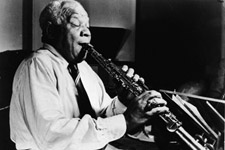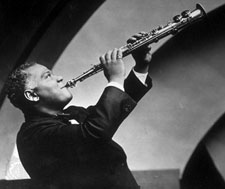Sidney Bechet
 Who was the New Orleans jazz pioneer who did most to make this music a unique art form? When this question is asked, the name of Louis Armstrong invariably comes to mind, and rightly so.
Who was the New Orleans jazz pioneer who did most to make this music a unique art form? When this question is asked, the name of Louis Armstrong invariably comes to mind, and rightly so.
But there is another jazz musician whose name deserves to be coupled with Armstrong as the greatest of the New Orleans Jazz players. His name is Sidney Bechet.
Bechet was born in New Orleans in May 1897, just three years before his compatriot, Louis Armstrong. Although the two boys grew up in the same city, their home environments were worlds apart.
Armstrong grew up in dire poverty, living alternately with his mother and a succession of “stepfathers” and his grandmother, and spending time in a reform school.
Sidney Bechet, who was of Creole ancestry, grew up in a middle class environment. His father, Omar, who was a shoemaker, played the flute as a hobby. Indeed, music had an important role in the Bechet household, as Sidney’s four brothers also played instruments.
His brother, Leonard, played the clarinet and trombone, and it was to the former instrument that eight-year-old Sidney was attracted. Leonard, whose main interest was the trombone, passed along his clarinet to his younger brother.
At first, Sidney played in the family musicales – waltzes, quadrilles, the polite music of the middle class. But as he grew into adolescence, Sidney was attracted to the syncopated music played in the dance halls and brothels in the Storyville District of New Orleans.
As a boy, he would watch the street parades in which jazz bands played. Young Sidney was so attracted to the music, that he often played hooky from school. And as he became more proficient on the clarinet, Sidney played in local jazz bands, such as the Young Olympians. His playing so impressed Bunk Johnson, the legendary cornet player, that Sidney was invited to join Johnson’s band, the Eagle Band. Sidney gained much experience, playing in dance halls, and for picnics, and parties.
Bechet left New Orleans for the first time when he was 19, traveling to Chicago with pianist, Clarence Williams and his variety show. Bechet’s big break came in 1919 when the composer-conductor Will Marion Cook asked him to join his Southern Syncopated Orchestra for an engagement in London.
Here Bechet came to the attention of the noted Swiss Conductor, Ernst Ansermet, who conducted the music of Stravinsky for the Ballets Russa. Ansermet wrote in a Swiss musical Journal, “The extraordinary clarinet virtuoso Bechet is an artist of genius!”
Sidney Bechet eventually became even better known as a virtuoso of the soprano saxophone. He first tried to play on a beat-up old soprano sax he purchased in a pawn shop. Such was the difficulty of the soprano sax, an instrument extremely difficult to play in tune, that Bechet gave up and obtained his money back from the pawnbroker.
A year latter in London, Bechet purchased a brand new instrument and tried again. This time he was successful and succeeded in making the soprano saxophone an important voice in jazz.
Bechet played both the clarinet and soprano saxophone with a broad vibrato, a characteristic that gave passion and intensity to his playing.
Much of Sidney Bechet’s subsequent career was spent abroad. In 1925 he played in Claude Hopkin’s band, which was accompanying a revue starring Josephine Baker. Bechet also played in bands led by Noble Sissle in London and Paris, and later, in the United States. Some of the numbers performed and recorded by Bechet with Nobel Sissle are Loveless Love, Polka Dot Rag, and Dear Old Southland.
In 1932, Bechet and his friend, trumpet player Tommy Ladnier, formed their own band, the New Orleans Feetwarmers. When engagements for the Feetwarmers became scarce, Ladnier and Bechet opened a dry cleaning shop in Harlem. Bechet became quite adept at pressing and altering clothes.
Sidney Bechet’s association with Brooklyn began in 1945 when he moved into a house at 160 Quincy Street. To augment the unstable income of a jazz musician, Bechet began teaching music. The adolescent that became his star pupil and disciple was Bob Wilber, then still in high school. Bechet taught Wilber the rudiments of both the clarinet and soprano saxophone. When he finished high school, Wilber moved into the Quincy Street house with Bechet so that he could have longer and more frequent lessons. Today, Bob Wilber is a leading exponent of the soprano sax and clarinet, and with his own group, the Bechet Legacy, he plays in the Bechet tradition.
Much of the latter part of his life, Bechet spent in France. Many of his compositions are inspired by his love for that country. They include Petite Fleur, Rue des Champs Elysees, and Si tous vois ma mere. Other Bechet compositions include Chant in the Night, Blues in the Air, Bechet’s Fantasy, and his ode to his Brooklyn home, Quincy Street Stomp.
Sidney Bechet died in Paris, May 14, 1959. In July 1997, The Sidney Bechet Society has been formed to perpetuate the name and fame of Sidney Bechet. To that end, the Sidney Bechet Society sponsors concerts, symposia, in-depth studies, a newsletter, change the name of Quincy Street to Bechet Street and a Website to carry the appreciation of this great jazz pioneer into the next century.
Copyright By The Sidney Bechet Society, Ltd.

